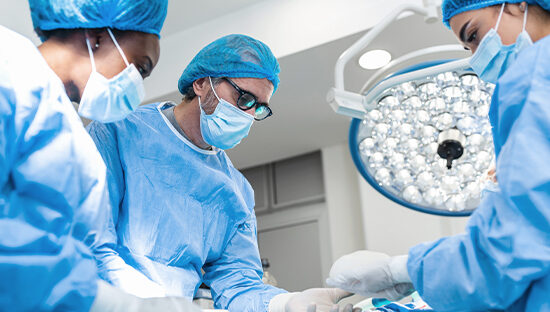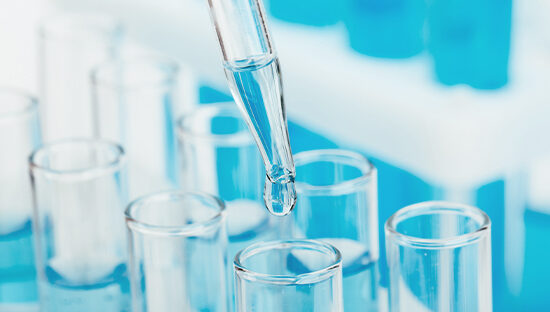
Hydrogen peroxide vapour (HPV), as we know it, has been employed for decades in bio-decontamination technology systems to decontaminate hospitals and decrease rates of hospital-acquired infections.
HPV was shown to kill microorganisms by interacting with their lipid membranes and disturbing their genetic material (DNA/RNA) eventually leading to mutagenesis and cell death as a result of its oxidising reactions. In addition to its antimicrobial properties, HPV can be easily degraded into non-toxic products (water and oxygen), making it a safer option than other disinfectants or sterilants such as ethylene oxide and formaldehyde.
What are the two phases of hydrogen peroxide?
Hydrogen peroxide has two phases: a liquid and gas phase. Bio-decontamination technology developers and manufacturers usually utilise one of these phases in their decontamination cycles. Such technologies are highly influenced by a variety of cycle variables known as cycle parameters.
These parameters are measurable factors that control the success of HPV decontamination cycles and affect surrounding conditions, including temperature, hydrogen peroxide concentration, humidity, relative saturation and condensation. They highly influence the inactivation of microbes and successful cycle development, and the real challenge in HPV decontamination is not a matter of antimicrobial efficacy, but rather developing a process that is efficient and effective.
Therefore, more focus must be shifted to the fact that different technologies measure different parameters which interfere with successful decontamination cycle development and hence influence efficacy results.
Briefly, a hydrogen peroxide bio-decontamination process involves HPV that is pumped into the chamber at a given concentration measured in parts per million (PPM), temperature, humidity and for a given amount of time. Once the decontamination cycle has completed, the vapour is deactivated and converted to water and oxygen prior to the cycle completing and the doors being allowed to open.
Hydrogen Peroxide Vapour Decontamination Phases
Prior to proceeding to the technical and scientific bits of this article, we first must understand the differences of hydrogen peroxide vapour decontamination phases and some terms such as dew point, efficacy, relative saturation and condensation.
Relative saturation is the parameter that indicates the amount of humidity in the air caused by both hydrogen peroxide and water vapor. The air mixture starts to condense when the relative saturation reaches 100 % RS. In other words, at a given temperature, air can only hold a certain amount of water and hydrogen peroxide vapour, this is known as the dew point. Just as water will boil and evaporate more readily than hydrogen peroxide, the opposite is true when condensation occurs.
Should a mixture of the vapours become too concentrated (saturated) or cooled to the dew point, peroxide will be the first to condense. This reduces its concentration in the vapour phase and creates tiny droplets of concentrated peroxide on surfaces. When condensation is avoided, the process is termed as a “dry process”, and when condensation is occurred would be termed a “wet process”.
Efficacy of successful cycles are measured and validated through the use of Biological indicators. BIs are produced with high inoculation of microorganisms dried within a 1 cm2 area using i.e. Geobacillus stearothermophilus spores, which have demonstrated a high resistance towards steam and vaporised hydrogen peroxide.
Measurement Parameters
As it is safe to say that different technologies define their decontamination cycles using different parameters it is also safe to say that it might get increasingly more difficult to understand how effective decontamination cycle is achieved and how different technologies compare.
Most would agree that there is a certain level of convenience in using single cycle parameter – hydrogen peroxide vapour decontamination cycle can be expressed using easy to understand measurements i.e. mass (g) of hydrogen peroxide injected into one cubic meter of air per given time period.
However, HPV decontamination cycle is not that simple. This clearly presents a challenge when efficacy tests are carried out and results are being linked to a single cycle parameter that technology developer can control. A given mass of hydrogen peroxide injected into one cubic meter of air might return required efficacy result when injected in a presence of specific environmental conditions i.e. at given relative humidity and temperature.
The expected results are likely to be different if the environmental conditions change in ”real word” practice. In this case – the single cycle parameter, an amount of hydrogen peroxide injected, that must be variable and should adapt based on starting cycle conditions is ‘locked’ in and presented as constant when in reality almost every environment is different. Each treatments space will differ in starting relative humidity, temperature and contents in the room which defines surface area to be decontaminated (this list goes on) – all of which need to be accounted for by the VHP decontamination systems and technology. It’s tricky and it can get confusing for the end user, specifically when some systems rely on operator input i.e. entering of the size of the treatment space to work out effective cycle.
It is seen that effective killing of microorganisms can be achieved with different humidity and hydrogen peroxide ppm levels. Some manufacturers of bio-decontamination chambers or isolators prefer subvisible condensation, whereas others prefer dry bio-decontamination processes where humidity is maintained far from condensation.
Some literature reveals disagreement on the optimum conditions for microbial inactivation concerning relative humidity, hydrogen peroxide concentration, and temperature. There is also debate concerning whether condensation is needed for the mode of microbial inactivation or if a dry cycle is preferential. Several publications propose a direct correlation between the concentration of the vapor in the chamber air and the antimicrobial efficacy. In contrast, some authors report high inactivation rates with comparatively low hydrogen peroxide concentrations, while others question a correlation between measured hydrogen peroxide concentration and the absolute antimicrobial efficacy.
A study published in the Journal of Pharmaceutical innovation, examined the factors influencing the effectiveness of surface decontamination with hydrogen peroxide vapor. The technology operated in open-loop mode at 22 degree C. The sporicidal agent used was 35% hydrogen peroxide and the water vaporized for the regulation of the humidity was high-performance liquid chromatography Gradient. They investigated the use of 800 ppm versus 400 ppm of hydrogen peroxide.
The results indicate that an increasing concentration of hydrogen peroxide in the gas phase and higher humidity levels result in a faster inactivation of the test organisms. The higher the HPV gas phase concentration was (800pm), the more independent the inactivation effect from the humidity level. At lower H2O2 concentrations (400pm), the same kill was achieved with higher humidity. Subvisible condensation was found to be necessary for short inactivation times, but condensation in the visible range did not further enhance the sporicidal activity.
The molecular deposition of water and hydrogen peroxide on the target surface represents the determining factor for microbial inactivation, whereas the hydrogen peroxide concentration in the gas phase is of secondary importance. The process of the formation and the microscopic deposition of aqueous hydrogen peroxide solution on the chamber surfaces sometime is referred to as “micro-condensation”.
It can be seen from the mentioned studies, that the variation in results interpretation was highly associated with the use of different technologies and different hydrogen peroxide phases. Such differences can be linked with the fact that these technologies have a different approach to cycles development.
Modern decontamination technologies, should by design, be able to electronically monitor cycle variables (parameters) and technology developers should be able to develop new systems that can measure all these parameters – temperature, humidity, concentration, as well as condensation, and be able to perform automated adjustments during any of the cycle phases, if required, as well as providing constant monitoring of these parameters without relying on external equipment. HPV systems that measure temperature, humidity, injection rates and air flow over time can show that conditions in controlled trials with biological indicators were met and the operator can be notified immediately.
Based on the above – this should be the way forward for the link between the laboratory efficacy result and real word process result to be maintained.




